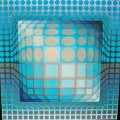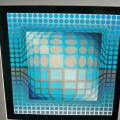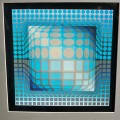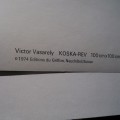Victor Vasarely ( 1906 - 1997 )
Né à Pécs en Hongrie, il suivit une formation en médecine, qu'il quitta au bout de deux ans. Il s'intéressait alors à l'art abstrait et à l'enseignement du Bauhaus au “Muhely” de Budapest.
En 1930, il s'installe à Paris où il débute comme artiste graphiste dans des agences publicitaires comme Havas, Draeger, Devambez. C'est là qu'il effectue son premier travail majeur, Zebra (1938), considéré aujourd'hui comme le premier travail dans le genre Op art. Pendant les deux décennies suivantes, Vasarely développe son propre modèle d'art abstrait géométrique, travaillant dans divers matériaux, mais employant un nombre minimal de formes et de couleurs. Il travailla pour de nombreuses entreprises et métamorphosa, avec Yvaral, en 1972, le logo de Renault.
Il créa pour cela la Fondation Vasarely, reconnue d'utilité publique en 1971, comprenant le musée didactique de Gordes (1970 - 1997) et le centre architectonique d'Aix-en-Provence (1976) et deux musées « didactiques » à Pécs (1976) et à Budapest (1986).
Les musées Vasarely de Pécs et de Budapest conservent des donations inaliénables : celui de Pécs possède des œuvres d'autres artistes de sa collection (Soto, Morellet, Yvaral, Claire Vasarely).
Vasarely décède à Paris le 15 mars 1997, à l'âge de 91 ans. Il est le père de l'artiste Yvaral, qui produisit des œuvres dans le même style et le grand-père de Pierre Vasarely, son légataire universel.
VICTOR VASARELY (1906-1997)Victor Vasarely (I906-1997) is internationally recognized as one of the most important artists of the 20th century. He is the acknowledged leader of the Op Art movement, and his innovations in color and optical illusion have had a strong influence on many modern artists. In 1947, Vasarely discovered his place in abstract art. Influenced by his experiences at Breton Beach of Belle Isle, he concluded that "internal geometry" could be seen below the surface of the entire world. He conceived that form and color are inseparable. "Every form is a base for color, every color is the attribute of a form." Forms from nature were thus transposed into purely abstract elements in his paintings. Recognizing the inner geometry of nature, Vasarely wrote, "the ellipsoid form ... will slowly, but tenaciously, take hold of the surface, and become its raison d'etre. Henceforth, this ovoid form will signify in all my works of this period, the 'oceanic feeling'...l can no longer admit an inner world and another, an outer world, apart. The within and the without communicate by osmosis, or, one might rather say: the spatial-material universe, energetic-living, feeling-thinking, form a whole, indivisible ... The languages of the spirit are but the super vibrations of the great physical nature." Vasarely was born in Pecs, Hungary in 1906. After receiving his baccalaureate degree in 1925, he began studying art at the Podolini-Volkmann Academy in Budapest. In 1928, he transferred to the Muhely Academy, also known as the Budapest Bauhaus, where he studied with Alexander Bortnijik. At the Academy, he became familiar with the contemporary research in color and optics by Jaohannes ltten, Josef Albers, and the Constructivists Malevich and Kandinsky. After his first one-man show in 1930, at the Kovacs Akos Gallery in Budapest, Vasarely moved to Paris. For the next thirteen years, he devoted himself to graphic studies. His lifelong fascination with linear patterning led him to draw figurative and abstract patterned sub .ects, such as his series of harlequins, checkers, tigers, and In 1943, Vasarely began to work extensively in oils, creating both abstract and figurative canvases. His first Parisian exhibition was the following year at the Galerie Denise Rene that he helped found. Vasarely became the recognized leader of the avant-garde group of artists affiliated with the gallery. |
From WWW.fineart.com
 VENDU - SOLD - KOSKA-REV par les Éditions du griffon supervisé par Vasarely et Marcel Joray
VENDU - SOLD - KOSKA-REV par les Éditions du griffon supervisé par Vasarely et Marcel JorayAnnée : 1974
40x40 cm. - 15 1/2 x15 1/2 in.
Prix : $ 550.
 VENDU - SOLD - Estampe originale Koska-REV. imprimé par la maison édition du Griffon Neûchatel Suisse
VENDU - SOLD - Estampe originale Koska-REV. imprimé par la maison édition du Griffon Neûchatel SuisseAnnée : 1974
Medium : Estampe origin des éditions du griffon- original print from édition du Griffon
40 X 40 cm. - 15½ x 15½ in
Prix : $ 550.
« Retour / Home

